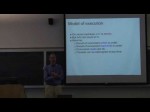June 13, 2012

Software Synchronization Puzzles Multithreaded applications often require synchronization constraints; for example, we might require one thread to write a value before another thread tries to read it. A semaphore is a software building block that can be used to enforce arbitrarily complex constraints, but getting the details right can be challenging. In the Little Book of Semaphores, I present this material using a series of puzzles, starting with basic patterns, working through classical synchronization problems like Readers-Writers and Dining Philosophers, and ending with some new problems constructed by my students. In this talk I will introduce semaphores, basic synchronization patterns and a few classical problems. I will demonstrate (and test) solutions to these problems using an animated thread simulator called Sync. The Little Book of Semaphores and Sync are available from Green Tea Press. Allen Downey is an Associate Professor of Computer Science at the Olin College of Engineering in Needham MA, and a Visiting Scientist at Google, Inc. He is the author of How to Think Like a Computer Scientist and several other Free Books.
Tags: acm, animated-thread, college, dining, functioning abnormally, green, multithreaded, press-allen, science & technology, semaphore, students, synchronization, these-problems
Posted in Software Functioning Abnormally | No Comments »
February 9, 2012

This is the VOA Special English Technology Report, from voaspecialenglish.com | http June eighth was World IPv6 Day — the first major deployment of Internet Protocol version 6. Hundreds of Internet service providers and Web companies tested IPv6 on their websites. This new numbering system for Internet addresses has been available for years. But very few companies have switched to it. Yet the old system could run out of addresses this year because of all the growth in online devices. Computer science professor Doug Szajda at the University of Richmond in Virginia explains: “It’s sort of like the post office of the Internet. It tells you how to get information from one computer to another. Currently, and since around nineteen eighty, the addressing system has been IP version 4. But the problem with that is that we’ve run out of addresses. So it’s almost as if, when a new house is built, you can’t give it an address because you don’t have any more.” IPv4 was designed to handle just over four billion IP addresses. Doug Szajda says that seemed like more than enough. “At the time that IP version 4 was designed, the designers were anticipating perhaps thousands of users of the Internet someday, and certainly thinking that four billion addresses was many more than we would ever need.” Yet now, not just computers but smartphones, cars, televisions, game systems and plenty of other devices all connect to the Internet. Each uses a different IP address. The basic standards for IPv6 …
Tags: addressing, controlled, get-information, higher, internet, ipv6-on-their, mp3, radio control, report, students, teacher, tertiary, time, windows
Posted in Slow Working Computer | No Comments »
October 9, 2011

This is the VOA Special English Technology Report, from voaspecialenglish.com | http Sony officials held a news conference in early May in Tokyo. They apologized for the theft of personal information from millions of users of the company’s online services. Hackers targeted Sony’s PlayStation Network, Sony Online Entertainment and Qriocity music systems. In all, Sony says information may have been stolen from more than one hundred million accounts. The data includes information like names, addresses, phone numbers and birthdates. In some cases, even credit and debit card numbers may have been stolen. The United States Federal Bureau of Investigation is looking into the cyber attacks. Sony shut down its PlayStation Network on April twentieth. The company is being criticized for not telling its users about the stolen information until a week later. Sony has also been criticized for not making its accounts more secure by encrypting the data. Sony officials say they have now taken steps to improve security. Peter Warren is chairman of the Cyber Security Research Institute in London. His group studies technology crimes and their effects on our computer-dependent world. Mr. Warren points out that what happened at Sony is not rare: “We’ve seen a number of very large companies that have suffered some tremendously embarrassing losses of data.”The problem, he says, is that there is far more interest in developing technology than in keeping it safe. As he puts it: “Lots and lots of …
Tags: been-criticized, controlled, culture, download, gardening, health, jailbreak, network, news, online, special, students
Posted in Internet Network Problem | No Comments »
August 24, 2011

freeebooksbb.blogspot.com Modelling, Simulation and Software Concepts for Scientific-Technological Problems by Ernst Stephan, Peter Wriggers ****ger | 2011 | ISBN: 3642204899 | 261 pages | PDF | 34 MB The book includes different contributions that cover interdisciplinary research in the areas of Error controlled numerical methods, efficient algorithms and software development Elastic and in elastic deformation processes Models with multiscales and multi-physics SHigh Performance adaptive numerical methods using finite elements (FEM) and boundary elements (BEM) are described as well as efficient solvers for linear systems and corresponding software components for non-linear, coupled field equations of various branches of mechanics, electromagnetics, and geosciences.
Tags: cellphones, computer hacks, downloads, math, modelling, programs, schools, simulation, students, tech
Posted in Software Functioning Abnormally | No Comments »






